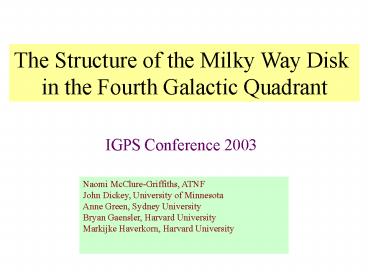The Structure of the Milky Way Disk - PowerPoint PPT Presentation
1 / 39
Title:
The Structure of the Milky Way Disk
Description:
Sagittarius - Carina. The simplest thing on the l-v diagram is the ... Profiles in latitude. look like : HI Disk Midpoint (past studies) ... – PowerPoint PPT presentation
Number of Views:48
Avg rating:3.0/5.0
Title: The Structure of the Milky Way Disk
1
The Structure of the Milky Way Disk in the
Fourth Galactic Quadrant
IGPS Conference 2003
Naomi McClure-Griffiths, ATNF John Dickey,
University of Minnesota Anne Green, Sydney
University Bryan Gaensler, Harvard
University Markijke Haverkorn, Harvard University
2
- We map the 21-cm line and continuum
- radiation in the longitude range 2550 - 3570,
- latitude -10 to 10 with resolution 2 arcmin
- latitude -100 to 100 with resolution 15 arcmin.
3
The Longitude-Velocity Diagram
4
Locus of Tangent Points
The simplest thing on the l-v diagram is the ...
At the tangent point
d
Rg
Nominal spiral arms
Model electron density Cordes Lazio (2001)
5
A deeper version of the l-v diagram ...
The terminal velocity edge is quite sharp.
6
Consecutive l-v diagrams averaged over 0.1 degree
steps in latitude from b 0.5o to b -0.5o.
7
threshold in TB
l325.5 deg
8
The threshold-crossing velocity as a function of
longitude and latitude
9
(aside)
Sunset over the ocean ? No, its just the
terminal velocity vs. latitude and longitude...
10
At each longitude, we look at the threshold
crossings at every latitude, and see how they are
distributed in velocity.
We look at the distribution, find the median and
percentiles.
11
The Milky Way Rotation Curve Percentiles
(20, 50, and 80) of latitude slices within b
lt 10 crossing a 25 K threshold.
12
How does the brightness temperature (HI column
density) drop off beyond the terminal velocity ?
s v 7.6 km/s
An average of all spectra with 290 lt l lt 340 b
lt 12 arc min (18,000 beam areas) shifted
to align the terminal velocities at v0.
s v 16.8 km/s
13
Northern () and Southern (.) Hemisphere data on
the terminal velocity vs. sin(l) RG / Rsun .
14
The Rotation Curve Depends on Qsun
km s -1
Rgal / Rsun
15
Terminal velocity data translated into
circular rotation velocity (the rotation curve)
16
Terminal velocity data translated into
circular rotation velocity (the rotation curve)
Brand and Blitz (1993)
17
Terminal velocity data translated into
circular rotation velocity (the rotation curve)
18
Terminal velocity data translated into
circular rotation velocity (the rotation curve)
Clemens 1985
19
Terminal velocity data translated into
circular rotation velocity (the rotation curve)
20
Terminal velocity data translated into
circular rotation velocity (the rotation curve)
Best fit Brandt Curve
V max 228 km s -1, R max 8.5 kpc, n 0.7
21
Terminal velocity data translated into
circular rotation velocity (the rotation curve)
22
Scutum-Crux
Norma
Sgr-Carina
Scutum-Crux
23
The Cordes and Lazio model (and the Taylor and
Cordes model) shows an arbitrary pitch angle
change in the Sgr-Car arm just inside the solar
circle. Could this explain the offset ?
Sagittarius - Carina Arm Pitch angle
variation ?
24
The density-wave model predicts that the gas
should slow down its rotational motion as it
approaches a spiral arm (from the concave side,
inside corotation) because the acceleration is
mainly radial, causing the gas to slow down to
conserve angular momentum. This is exactly what
we see !
25
HI brightness temperature (density) at the
terminal velocity...
26
Measured at the terminal velocity (i.e. at the
sub- central point)
21-cm Brightness Temperature
Profiles in latitude look like
Galactic Latitude
Galactic Longitude
27
HI Disk Midpoint (past studies)
From Malhotra (1995) using published Parkes data
(boxes) and Dame et al (1987) CO data (line)
28
HI Disk Midpoint SGPS
First moment Parkes
First moment SGPS
Gaussian Fit center position
Scutum-Crux arm
Sgr-Carina arm
Norma spiral arm
29
HI Disk Scale Height (earlier studies)
From Malhotra (1995) using published Parkes data
30
HI Disk Scale Height (SGPS)
Second moment SGPS
Second moment Parkes
flare?
31
The H I Disk Scale Height
- The scale height increases at spiral arms
- 3 kpc arm, Norma arm, Scutum-Crux arm
- What causes the increase?
- Increased turbulent pressure in areas of active
star formation? - Spiral density wave?
- The flaring of the disk for Rg lt 7 kpc is not
strong, we see only an increase in scale height
of 60 pc over 4 kpc radial range.
32
Conclusions
- A smooth, Brandt curve can fit the Milky Way
- rotation curve in the radius range 2 to 8.5
kpc. - Departures from this smooth curve are aligned
- with the spiral arms in both quadrants IV and
I. - The sense of the departures agrees with
density- - wave theory prediction.
- The scale height increases weakly with radius.
- The scale height flares in the spiral arms.
- The midplane is strongly corrugated, apparently
- due to some unexplained effect of the spiral
arms.
33
(No Transcript)
34
(No Transcript)
35
(No Transcript)
36
(No Transcript)
37
Terminal velocity data translated into
circular rotation velocity (the rotation curve)
38
HI Disk Midpoint SGPS
Norma spiral arm
Scutum-Crux arm
3 kpc arm
39
HI Disk Scale Height (SGPS)
Scutum-Crux arm
3 kpc arm
Norma arm
flare?































